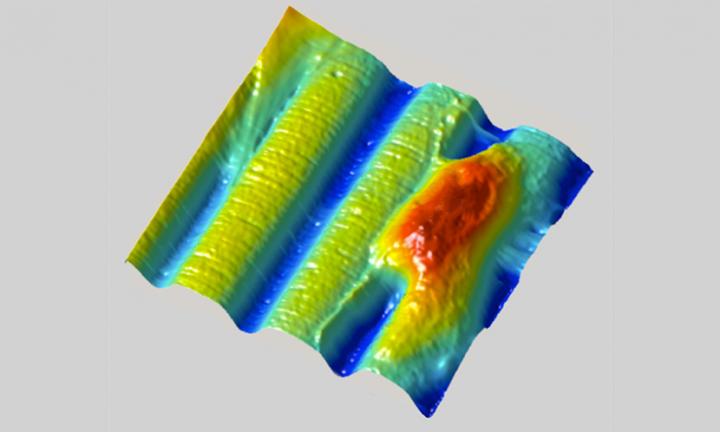
Using a new kind of “shrink ray”, UT Austin scientists can alter the surface of a hydrogel pad in real time, creating grooves (blue) and other patterns without disturbing living cells, such as this fibroblast cell (red) that models the behavior of human skin cells. Rapid appearance of such surface features during cell growth can mimic the dynamic conditions experienced during development and repair of tissue (e.g., in wound healing and nerve regrowth). Credit: Jason Shear/University of Texas at Austin
Researchers from the University of Texas at Austin have developed a laser-based ray device that can change the size and shape of a block of gel-like material that has human or bacterial cells growing on it, an innovation that could help scientists understand how to someday grow replacement tissues and organs for implants.
“To understand, and in the future engineer, the way that cells respond to the physical properties of their environment, you want to have materials that are dynamically re-shapeable,” Jason Shear, a professor of chemistry and co-inventor of the new tool, said in a statement.
The device is able to selectively change the shape and texture of the surface by controlling precisely which parts of the interior of the material shrink, enabling the researchers to create specific 3D features on the surface including bumps, grooves and rings.
The researchers also can change the location and shapes of surface features over time by mimicking the dynamic nature of the environment in which cells typically live, grow and move.
The ‘shrink ray’ is a near-infrared laser that can be focused onto small points inside the substrate—the material used to grow cells. On the microscopic level, the substrate is made of proteins jumbled and intertwined.
When the laser strikes a point within the substrate, new chemical bonds are formed between the proteins. This draws the proteins in more tightly, which alters the surface shape as it’s tugged on from below.
The laser is scanned through a series of points within the substrate to create any desired surface contour at any place in relation to the targeted cells.
While other methods heat or chemically alter the surface to change the substrate under living cells, damaging living cells or causing them to unstick from the surface, the new device allows the formation of any 3D pattern on demand while viewing the growing cells through a microscope.
The researchers plan to use the tool to investigate fundamental scientific questions surrounding cellular growth and migration, which could lead to more materials and procedures that would promote wound healing and nerve regrowth or assist in growing and successfully implanting replacement tissues like skin or heart valves.
“To get tissues to grow in a dish that will be effective once implanted, we need to first understand, then better mimic the environment in which they typically develop in our own bodies,” Shear said.
The device could also be used in basic research of how the topography of a surface affects the formation of dangerous biofilms. A better understanding of what topographic features prevent biofilms from forming and how features that change over time could influence the process, could result in the ability to develop coatings for biomedical devices that block biofilm formation and prevent hard-to-treat infections.
The study was published in the Journal of the American Chemical Society.




